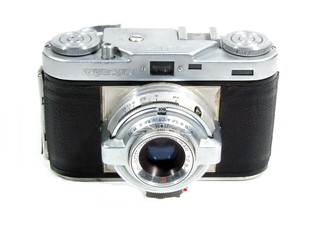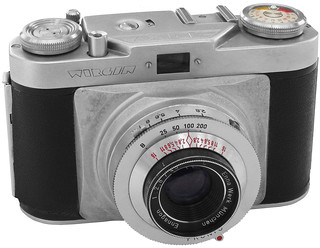Wirgin Edixa
In 1953 Wirgin intended to replace its successful Edinex viewfinder cameras with a more up-to-date model of viewfinder camera, which they named Edina. The new cameras were not as compact as their predecessors. The concept was to have just one body version for both the viewfinder version of this camera, called Edina I, and the rangefinder version, called Edina II. The sides of the body were rounded like those of a Leica. But copyright troubles were not made by Leitz but by Kodak AG. The competitor complained about the similarity of the name Edina to Kodak AG's camera type name Retina. In 1954 the cameras were renamed to Edixa I and Edixa II. The new name was chosen as compromise between Edinex and Edina by Wirgin's British sales representative Charles G. Strasser.
The most characteristic style element of the Edinas is the metal part that is a mask for the shutter speed scale as well as depth-of-field scale and tube side stabilization element. This part helped to make the lens tube a little more robust than other constructions. The rangefinder of the Edina II and Edixa II was coupled but separate from the viewfinder. It showed a smaller split image. When the image parts matched to give one image the front lens element was adjusted properly for the measured distance. Some of the old Edixas have a more conventional frontside, maybe needed to get another shutter mounted. The most of the cameras had a shutter with mechanical self-timer (red lever on the lens tube), and all had a flash shoe on top.
The Edixa cameras were the base on which the Edixa Stereo rangefinder camera was developed.
Interestingly, Wirgin continued to manufacture Edinex cameras even after the Edina and later Edixa cameras were being sold. The sale of Edinex cameras continued until long after the "replacement" Edixa rangefinder line had ceased.
Contents
Specifications Edina II (=Edixa II, with characteristic frontside)

|
| Wirgin Edixa II image by Süleyman Demir (Image rights) |
- Type: rangefinder camera
- Manufacturer: Wirgin
- Year of launch: 1952
- Film: 35mm
- Lens: Isco-Göttingen Jsconar 1:2.8/43mm
- Viewfinder: optical
- Focusing: turnable front lens element adjustable for distances from 1m to infinity with help of split image rangefinder
- Shutter: Prontor S with speeds 1 sec. to 1/300 sec and B, opens only with film in camera, speed 1/50 or slower flash synchronized, a variant of the camera had a Prontor-SVS shutter instead
- Aperture: 1:2.8 to 1:16
- Film transport: Long lever and rewind thumb wheel. Since 1953 the camera was equipped with a short lever which was more adequate since the "rapid" lever needed two 180 degree movements to advance the film and to cock the shutter for the next exposure
Specifications Edixa I (conventional frontside)

|
| Edixa I with conventional frontside and Pronto shutter image by Alf Sigaro (Image rights) |
- Type: viewfinder camera
- Manufacturer: Wirgin
- Year of launch: 1954
- Film: 35mm
- Lens: Enna Ennagon 1:2.8/45mm
- Viewfinder: optical
- Focusing: turnable front lens element
- Shutter: Pronto with speeds 1/25 sec. to 1/200 sec and B
- Aperture: 1:2.8 to 1:16
- Film transport: Lever and rewind wheel
Specifications Edixa Vero (conventional frontside)
- Type: viewfinder camera
- Manufacturer: Wirgin
- Year of launch: 1953
- Film: 35mm
- Lens: Steinheil Cassar 1:2.8/45mm
- Viewfinder: optical
- Focusing: turnable front lens element
- Shutter: Vero with speeds 1/25 sec. to 1/200 sec and B
- Aperture: 1:2.8 to 1:16
- Film transport: Lever and rewind wheel
The Oga was nearly the same variant. The difference was its Prontor-SVS shutter. It was made for the camera trader Obergassner who sold it to the mail order house Otto. Another early version of the Edina/Edixa had a Wirgin Edinar lens and a Vario shutter
Links
- original manual for Edina I and II at Michael Butkus Jr.'s
- manual for Edixa I and II, HTML version, at Michael Butkus Jr.'s
- manual for Edina I and II (archived) at F. and S. Marriott's
- Edixa II review at Alex Luyckx Blog
- Edixa II at Klaus-Eckard Riess's pages (in German)
- Edixa Vero at Kurt Tauber's (German source)
- Oga (Edixa I) at Gérard Even's (in French)
- Wirgin Edixa II on www.collection-appareils.com by Sylvain Halgand (in French)